|
|
Published February 21st, 2018
|
Digging Deep with Cynthia Brian
|
| And the winner is... |
| By Cynthia Brian |
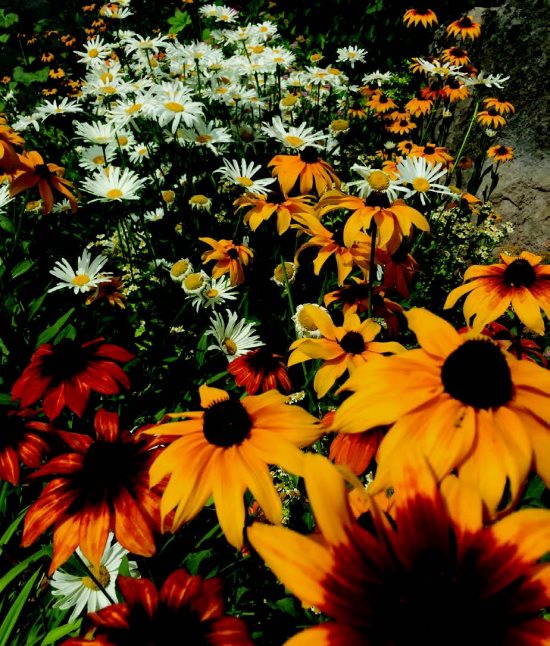 |
| Award winners in the garden world, Black-Eyed Susan and 2018 Coreopsis and Daisies. Photos Cynthia Brian |
In the first three months of the year, we get to be bystanders at numerous red carpet events. Hello awards season! The Golden Globes, People's Choice, Screen Actors Guild Awards, the Grammy's, and the Oscars are all highlights. Add the Olympics to this year's lineup and we have a full roster of gold, silver and bronze. Over the years I've been privileged to enjoy my share of walking the red carpet in the entertainment industry, and in the plant world, we have our winners, too.
 The Perennial Plant Association awarded Allium Millenium the plant of the year. It boasts glossy green leaves with a profusion of large, rosy-purple clusters of flowers that bloom in mid-summer. As butterfly magnets, alliums are beautiful as well as being deer and rabbit resistant. The Perennial Plant of the Year program showcases outstanding perennials that grow in a variety of climates, are disease free, and are low maintenance. A few of the past winners over the years have included lavender, which deer and rabbits won't eat as well as dianthus, phlox, black-eyed Susan (rudbeckia), echinacea, salvia, catmint, sage and coreopsis.
The Perennial Plant Association awarded Allium Millenium the plant of the year. It boasts glossy green leaves with a profusion of large, rosy-purple clusters of flowers that bloom in mid-summer. As butterfly magnets, alliums are beautiful as well as being deer and rabbit resistant. The Perennial Plant of the Year program showcases outstanding perennials that grow in a variety of climates, are disease free, and are low maintenance. A few of the past winners over the years have included lavender, which deer and rabbits won't eat as well as dianthus, phlox, black-eyed Susan (rudbeckia), echinacea, salvia, catmint, sage and coreopsis.
 The National Garden Bureau also designates award winners annually. For 2018, the winning bulb is the tulip, the vegetable is the beet, the perennial is the coreopsis, and the star of containers and hanging baskets is the Calibrachoa.
The National Garden Bureau also designates award winners annually. For 2018, the winning bulb is the tulip, the vegetable is the beet, the perennial is the coreopsis, and the star of containers and hanging baskets is the Calibrachoa.
 With the unusually warm weather we've experienced this February, gardens have exploded into blooms more than a month earlier than in previous years. With the slightest breeze, the sky rains white petals from pear and plum trees while hillsides and paths are lined with dancing daffodils.
With the unusually warm weather we've experienced this February, gardens have exploded into blooms more than a month earlier than in previous years. With the slightest breeze, the sky rains white petals from pear and plum trees while hillsides and paths are lined with dancing daffodils.
 The vivid, paint-box colors of tulips are filling our souls with joy. Part of the lily family and relatives of alliums, tulips comprises 150 species with over 3,000 varieties. Although we plant them in fall after four to six weeks of cooling for spring sprouting, they can be forced to bloom in winter. People often ask me why tulip bulbs need to be refrigerated before planting. The answer is that in their native habitats where winters are colder, they would go dormant allowing for the bulbs to sprout roots while the development of the embryonic leaves and flowers inside the bulb occur. I lived in Holland for 18 months where
"tulpen" were the pride of every household, even tough tulips originated in Asia. Did you know that the Netherlands produce most of the world's annual tulip crop exceeding four billion bulbs annually? Tulip mania (tulpenmanie) reached its crescendo in 1637 when the bubble collapsed, and overnight, many rich traders became paupers. One bulb could buy a house on the Amsterdam canal. Folly! According to the Netherlands Flower Bulb Information Center, the United States is the biggest importer of Dutch bulbs to the tune of $1.3 million in wholesale prices annually. The colors of the tulip have significant meaning: red equals love, purple represents loyalty, and white whispers,
"I'm sorry!"
The vivid, paint-box colors of tulips are filling our souls with joy. Part of the lily family and relatives of alliums, tulips comprises 150 species with over 3,000 varieties. Although we plant them in fall after four to six weeks of cooling for spring sprouting, they can be forced to bloom in winter. People often ask me why tulip bulbs need to be refrigerated before planting. The answer is that in their native habitats where winters are colder, they would go dormant allowing for the bulbs to sprout roots while the development of the embryonic leaves and flowers inside the bulb occur. I lived in Holland for 18 months where
"tulpen" were the pride of every household, even tough tulips originated in Asia. Did you know that the Netherlands produce most of the world's annual tulip crop exceeding four billion bulbs annually? Tulip mania (tulpenmanie) reached its crescendo in 1637 when the bubble collapsed, and overnight, many rich traders became paupers. One bulb could buy a house on the Amsterdam canal. Folly! According to the Netherlands Flower Bulb Information Center, the United States is the biggest importer of Dutch bulbs to the tune of $1.3 million in wholesale prices annually. The colors of the tulip have significant meaning: red equals love, purple represents loyalty, and white whispers,
"I'm sorry!"
 The winning edible of the year is the beet and I am so thrilled as this is probably my favorite of all of the root vegetables. I planted my seeds directly in the soil last spring and am still harvesting. When I thin, I eat the seedlings. Beets like acidic soil and they withstand cooler temperatures before harvest. Colors are typically red, purple, yellow, or red with white ring stripes. They are consumed in salads, soups, and pickled. Rich in fiber, potassium, calcium, folic acid, and phosphorus, high in fiber, vitamin A and C, beets have more iron than most other vegetables.
The winning edible of the year is the beet and I am so thrilled as this is probably my favorite of all of the root vegetables. I planted my seeds directly in the soil last spring and am still harvesting. When I thin, I eat the seedlings. Beets like acidic soil and they withstand cooler temperatures before harvest. Colors are typically red, purple, yellow, or red with white ring stripes. They are consumed in salads, soups, and pickled. Rich in fiber, potassium, calcium, folic acid, and phosphorus, high in fiber, vitamin A and C, beets have more iron than most other vegetables.
 The red color comes from the antioxidant betalain, an excellent source of color pigment for natural dyes and coloring agents.
The red color comes from the antioxidant betalain, an excellent source of color pigment for natural dyes and coloring agents.
 The beauty, resilience, and popularity of coreopsis was a natural fit for the National Garden Bureau to add this glorious flower to its red carpet lineup. In the language of flowers, coreopsis means
"always cheerful," and these delightful natives of the Americas live up to this designation. Equally, at home in naturalized prairie settings or manicured landscapes, coreopsis provides a lovely sunny presence wherever they make their home. Although typically seen in colors of yellow and gold, many species also contain red, bronze and burgundy colors and have been commonly used as dyes in native fabrics. Before the introduction of coffee to America, Native Americans boiled the flowers into a warming tea.
The beauty, resilience, and popularity of coreopsis was a natural fit for the National Garden Bureau to add this glorious flower to its red carpet lineup. In the language of flowers, coreopsis means
"always cheerful," and these delightful natives of the Americas live up to this designation. Equally, at home in naturalized prairie settings or manicured landscapes, coreopsis provides a lovely sunny presence wherever they make their home. Although typically seen in colors of yellow and gold, many species also contain red, bronze and burgundy colors and have been commonly used as dyes in native fabrics. Before the introduction of coffee to America, Native Americans boiled the flowers into a warming tea.
 The newest star in the garden lineup is calibrachoa, with its 28 different varieties. A relative of the petunia, (although now recognized as it's own genus) calibrachoa hit the marketplace arriving from Brazil via Japan via Europe in the 1980s but were considered difficult to cultivate. They are beautiful plants that do well in containers and hanging baskets and this specialized treatment has turned out to be their niche market. They aren't really mini petunias, yet they are drought tolerant. Plant in well-drained acidic soil and provide six hours of direct sunlight per day. You will be rewarded with brilliant colors, fascinating streaks and stripes, eye-catching stars, and patterns that resemble the strokes of a brush. Your patio will be a floral artwork with calibrachoa in the honored lineup.
The newest star in the garden lineup is calibrachoa, with its 28 different varieties. A relative of the petunia, (although now recognized as it's own genus) calibrachoa hit the marketplace arriving from Brazil via Japan via Europe in the 1980s but were considered difficult to cultivate. They are beautiful plants that do well in containers and hanging baskets and this specialized treatment has turned out to be their niche market. They aren't really mini petunias, yet they are drought tolerant. Plant in well-drained acidic soil and provide six hours of direct sunlight per day. You will be rewarded with brilliant colors, fascinating streaks and stripes, eye-catching stars, and patterns that resemble the strokes of a brush. Your patio will be a floral artwork with calibrachoa in the honored lineup.
 With all of these award winners, my supreme favorite still lies with the exquisite lotus flowers that I enjoyed in Southeast Asia. The deep, rich colors, their versatile expressions, I am deeply, madly in love with lotus. Alas, I can't grow it here in my backyard pond.
With all of these award winners, my supreme favorite still lies with the exquisite lotus flowers that I enjoyed in Southeast Asia. The deep, rich colors, their versatile expressions, I am deeply, madly in love with lotus. Alas, I can't grow it here in my backyard pond.
 Speaking of winners, gigantic congratulations to Sal and Susan Captain of Captain Vineyards for being honored as the Moraga Business Persons of the Year! I am personally thrilled to see two stewards of the earth, farmers, gardeners, wine makers, and all around great individuals inducted into this hall of fame. Bravo!
Speaking of winners, gigantic congratulations to Sal and Susan Captain of Captain Vineyards for being honored as the Moraga Business Persons of the Year! I am personally thrilled to see two stewards of the earth, farmers, gardeners, wine makers, and all around great individuals inducted into this hall of fame. Bravo!
 Savor a respite in your landscape for the next few weeks before I offer you a plethora of chores that need attention. Enjoy your own company.
Savor a respite in your landscape for the next few weeks before I offer you a plethora of chores that need attention. Enjoy your own company.
 Keep doing what you love and you'll be a winner too. Roll out the red carpet for your favorite plants and get ready for a rowdy and rousing spring.
Keep doing what you love and you'll be a winner too. Roll out the red carpet for your favorite plants and get ready for a rowdy and rousing spring.
 Happy Gardening and Happy Growing!
Happy Gardening and Happy Growing! |
 |
| The bright fluorescent pink of Chinese Fringe. |
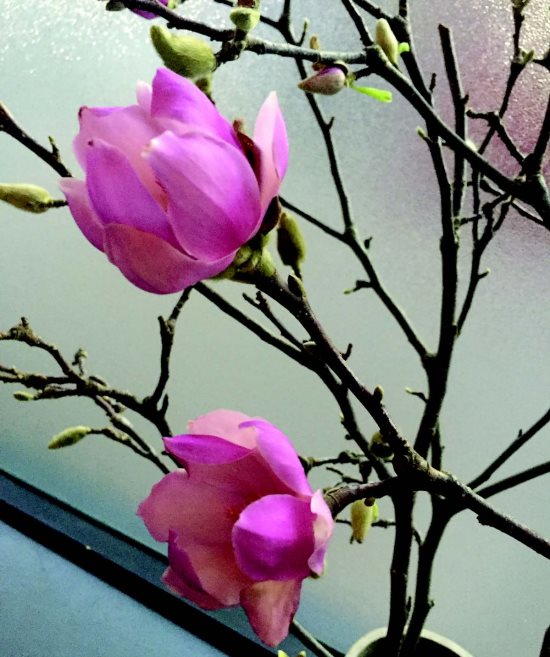 |
| Cut a branch from a gorgeous magnolia to highlight the end of winter. |
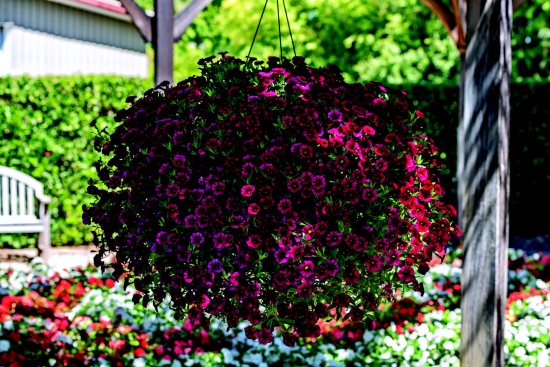 |
| The National Garden Bureau's Award Winner calibrachoa callie burgundy in a hanging basket. |
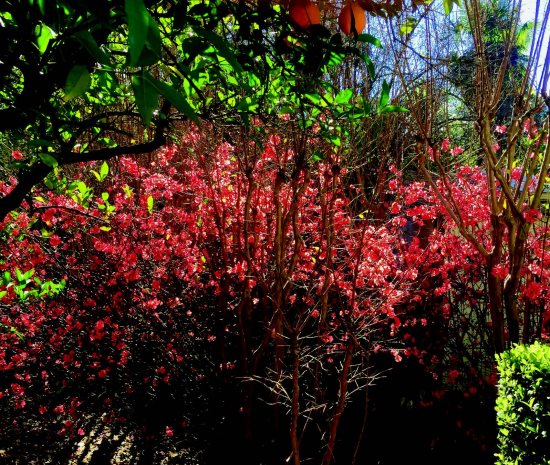 |
| Oranges in the forefront and flowering quince in the back of the garden. |
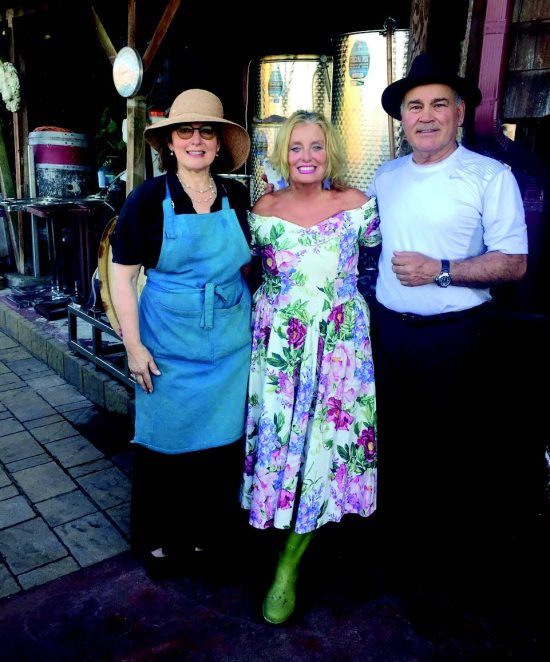 |
| Congratulations to Sal and Susan
Captain honored as Moraga's Business Persons of the Year. |
 |
| Cynthia Brian
walks the Red Carpet as one of the stars of the film "Tapping the
Source." Cynthia Brian, The Goddess Gardener, raised in the vineyards
of Napa County, is a New York Times best selling author, actor, radio
personality, speaker, media and writing coach as well as the Founder
and Executive Director of Be the Star You Are1(r) 501 c3. Tune into
Cynthia's Radio show and order her books at www.StarStyleRadio.com.
Her new book, Growing with the Goddess Gardener, is available at
www.cynthiabrian.com/online-store. Available for hire.
Cynthia@GoddessGardener.com
www.GoddessGardener.com |
| |
| |
|
|
|











